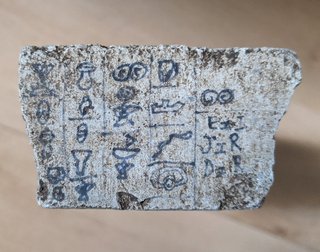Inscription discovered as stele mistakenly felled

The accidental toppling of an old memorial stone has led to the re-discovery of a forgotten inscription in an old ceremonial text.
Yesterday evening saw the old Wrythe Genocide Memorial accidentally knocked over by a watering can while nearby plants were watered.
The Memorial, unveiled for 2011’s International Holocaust Memorial Day in January of that year, once featured inscriptions commemorating the victims of genocide and expressing hope that such will never be repeated.
Many of these inscriptions were written in Moylurgian hieroglyphs, a writing system used in Austenasia for ceremonial purposes between 2010 and 2013.
However, the ink in which these inscriptions were made was not sufficiently waterproof to protect them from weathering, and by October 2012 the Memorial – which took the form of a small stone stele – was blank.
Over the years, the Memorial had gradually become forgotten, and due to having been erected in a flowerbed in Wrythe Public Park was often hidden behind plants and weeds.
Due to its deterioration, its dedication to genocide victims led to it being considered inappropriate to be publicised as such – with its neglect perhaps seen as a sign of disrespect – but simultaneously inappropriate to remove it. It was never designated an official national monument, a status introduced in December 2017; indeed, the legislation which introduced this status technically removed the remaining legal protections for the Memorial.
The re-discovery of the forgotten inscription on the bottom of the stele, protected by the soil from the rain and sunlight, is a major archaeological find for the history of Wrythe and of Austenasia.
Translated, it reads “Unveiled by His Imperial and Majestic Highness the King of Moylurg, Caesar of Austenasia”, referring to the now Emperor Jonathan I, and as such can be accurately dated to the short period of time – 19 October to 10 November 2010 – when he held the former office.
Indeed, by the time the stele was actually erected, the then Crown Prince no longer held the former title. The inscription is then followed by three ciphers: that of Emperor Esmond III, that of Jonathan I as King of Moylurg, and then that of Emperor Declan I, which was added after the rest of the inscription but before the unveiling of the memorial (Declan I having ascended the Throne in December 2010).
The inscription, nearly 12 years old, therefore hearkens back to a relatively tumultuous time deep in Austenasia’s past, remembered for the accession of different monarchs and the cultural influence of Moylurg (later Wilcsland).
The now Emperor Jonathan I has decided against re-inscribing or re-erecting the stele, stating:
“It is of the utmost importance that the horrors of genocide and the memories of its victims are never forgotten. However, it is inappropriate for us to pretend that a weathered brick in a flowerbed is in any way a fittingly dignified memorial to such. Instead of the stele being restored, we shall instead be making donations to various charities and museums which shall do a far better job than we could ever do at commemoration and education on this subject.”
Recent Comments